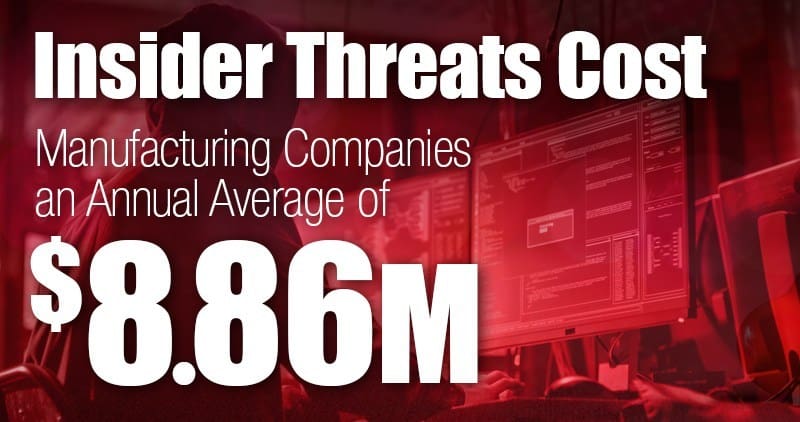WE HAVE A LOT TO SAY
IT SOFTWARE APPS CLOUD NEWS EVENTS
Insider Threats: What Small and Medium Sized Companies Need to Know
The manufacturing industry isn’t immune to insider threats — and without well-defined strategies to combat these attacks, companies are leaving themselves open to financial losses and more.
The average cost of an insider threat annually is $8.76 million, according to Ponemon Institute’s “2018 Cost of Insider Threats: Global” report.
Incident costs vary on a couple of factors, including organizational size and industry, the study found.
For instance, take companies with more than 75,000 employees. On average, they lose $20.01 million annually to insider threats — nearly 10 times more than firms on the lower end of the scale.
For obvious reasons, the financial services sector sees the brunt of insider threats. Due to these attacks, companies within this vertical lose an average of $12.05 million annually.
Insider threats cost manufacturing companies an average of $8.86 million annually.
While the figures outlined above are concerning, you may not fully understand the impact of insider threats on organizations of all sizes.
What are insider threats?
Believe it or not, not all threats originate from outside your network.
Insider threats are malicious attacks carried out by users with authorized access to your organization’s network — and these attacks are more common than you think.
Insider attacks make up nearly 20% of cybersecurity incidents and 15% of data breaches, according to Verizon’s recently released “Insider Threat Report.”
What you may not know is these attacks are performed by not only employees but independent contractors, interns, and other partners.
This should serve as a reminder to us all: Be careful when granting users access to your network (take proper precautions).
You never know when an outstanding employee will become disgruntled.
Why do insiders target organizations they’re closely associated with?
There are numerous reasons why insiders attack they’re closely connected with (top motivators include financial gain (47.8%), pure fun (23.4%) and espionage (14.4%), according to the report).
To help organizations with spotting potential threats, the study’s researchers identified several typical insider personalities:
- The Carless Worker (known for being negligent).
- The Inside Agent (an inside actor playing for the other team).
- The Disgruntled Employee (an employee with a grudge and willing to retaliate).
- The Malicious Insider (purely selfish in nature).
- The Feckless Third-Party (a hostile outside actor with inside access).
Each personality goes about attacking networks differently. Typically, the actions of the insider actor personalities above are as follows: misusing assets, stealing information on behalf of outsiders, destroying property, stealing information for personal gain and compromising security, respectfully.
Even though it’s fairly difficult for businesses to combat insider threats, it can be done if the right strategies are implemented and resources used.
What can you do to mitigate insider threats?
Deploying an effective insider threat program is no easy task, especially without any experience.
One of the best ways to mitigate insider threats is by implementing a security awareness program in your organization.
This training should inform insiders of not only types of malicious threats but effective countermeasures to reduce security risks.
Implementing security measures within your organization is another good way to mitigate insider threats.
There are several types of precautions to consider, including personnel, physical security, and data security.
If you’re still unsure how to properly protect your business from insider threats, seek an IT provider in your area.
Find one with experience in combatting insider threats and that can properly develop effective security measures for your organization.
Stay alert even when you’re not actively monitoring for insider threats.
Insider threats impact organizations of all sizes in all industries. Without the proper measures in place, your business is vulnerable to potential attacks from within.

